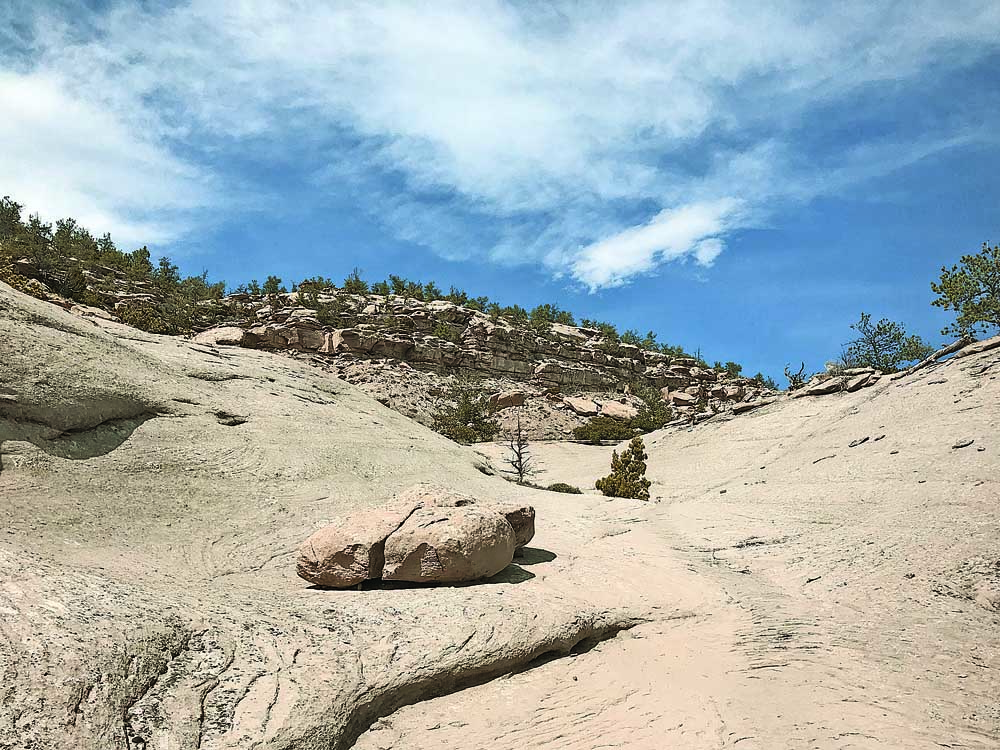Northern Cheyenne historian shares tribe’s mysteries
Published 12:00 am Thursday, October 18, 2018

- Sandstone features were avoided by Northern Cheyenne people because they believed they were the homes of the “little people.” (Brett French/The Billings Gazette)
In a sterile meeting room on the second floor of the Northern Hotel in downtown Billings, Montana, Linwood Tall Bull took a room full of “non-Indian scientific” history buffs on a mysterious, magical and supernatural oral tour of his Northern Cheyenne Tribe’s beliefs for a half hour recently.
He has seen the “little people” standing next to him, looking up with their sharp teeth. Some of these mystical creatures — similar to other cultures’ leprechauns, elves and fairies — live at the Madison Buffalo Jump State Park near Three Forks, he said, seen as flashes at the edge of his peripheral vision as they followed him.
“It’s a very spiritual place to climb,” he said.
Such “sand rock” formations like the buffalo jump are home to the little people, including Billings’ towering Rimrocks, he said.
Tall Bull was one of several individuals who spoke during the 2018 Montana History Conference. Tall Bull’s talk roamed from special places to events and stories of the Northern Cheyenne Tribe.
Different history
In addition to working as an instructor at Chief Dull Knife College in Lame Deer, Tall Bull is also one of the keepers of the Cheyenne oral tradition. Although his tales of the supernatural and mysterious can’t be verified by diaries, books, photos or news clippings like some other historical events, Tall Bull urged the attendees to keep an open mind.
“Many things are a mystery, and they need to remain a mystery,” he said. “Accept what they are. Don’t belittle it.”
He said superstitions were very real to his ancestors. For example, because sandstone geological features are homes to magical people, the Northern Cheyenne would never camp near them. “That was taboo.” Neither would they camp near springs, where three different-colored serpents dwelled. Same with sloughs and swamps, which were where “life began in the black mud.
“The Indian people dwell in the supernatural of many things,” Tall Bull said.
Origins
The Cheyenne Tribe is believed to have been pushed west from the Minnesota area in the 1600s, leaving behind their sedentary farming life to become nomadic buffalo hunters on the Great Plains.
Tall Bull tells a different story of the tribe’s early days in the West. According to oral tradition, the creator gave prophet Sweet Medicine the tribe’s covenants at Bear Butte, near present-day Sturgis, South Dakota. These items included four arrows and a buffalo hat. Five is a sacred number for the tribe.
“They were no different than the 10 Commandments,” Tall Bull said. “They are that special to our people.”
Bear Butte is also where Sweet Medicine led the buffalo out of the Black Hills. The mountain still retains significance to the tribe, Tall Bull said, as a place for vision quests — “a place of great suffering.”
Farther west, in the Bighorn Mountains of Wyoming, is the Medicine Wheel. Although revered by many tribes, Tall Bull said the Cheyenne claim ownership of it. Scientists have dated the existence of the wheel at somewhere between 500 and 1,500 years old.
Contact
By 1804, Meriwether Lewis and William Clark found the Cheyenne camped along the Missouri River as they explored the West for President Thomas Jefferson.
Clark wrote of the first encounter, “The Cheyenne Nation has about 300 lodges, hunt the buffalo, and steal horses from the Spanish settlements, which they do in 1 month.”
The movement west of Euro-Americans eventually overwhelmed all Indian nations, whose people were hunted by the U.S. Army before being placed on reservations. Tall Bull said the reservation agents would withhold food rations if the Indians did not send their children to schools or choose a Christian religion.
Because of this forced transition, the tribe’s culture has eroded away, Tall Bull lamented, to the point that many tribal members have lost touch with their own traditions and respect for spiritual places.
“The way the world is today, they don’t want children to pray in school or when they pick plants,” as he was taught, Tall Bull said.





